"Tesla Battery" is a type of battery that uses a lithium metal or a lithium alloy as a negative electrode material and uses a nonaqueous electrolyte solution. Lithium metal batteries were first proposed and studied by Gilbert N. Lewis in 1912. In the 1970s, MSWhitTIngham proposed and began researching lithium-ion batteries. Due to the very active chemical properties of lithium metal, the processing, storage and use of lithium metal are very demanding on the environment. Therefore, lithium batteries have not been used for a long time. With the development of science and technology, lithium batteries have become the mainstream.
Tesla batteries can be roughly divided into two categories: lithium metal batteries and lithium ion batteries. Lithium-ion batteries do not contain metallic lithium and are rechargeable. The fifth-generation lithium-metal battery of rechargeable batteries was born in 1996, and its safety, specific capacity, self-discharge rate and performance price ratio are better than lithium-ion batteries. Due to its own high technical requirements, only a few companies in the country are producing such lithium metal batteries.

For the battery life of electric vehicles, Tesla tried to give the owner a guarantee with a warranty: all Tesla cars have an eight-year, transferable, unconditional free warranty for batteries and transmissions.
However, the life of a typical Tesla battery is only two to three years. Tesla batteries are generally capable of charging and discharging 300-500 times. It is best to partially discharge the lithium battery instead of completely discharging it, and try to avoid frequent full discharge. Once the battery is off the production line, the clock begins to move. Lithium batteries last for only two to three years, whether you use them or not.
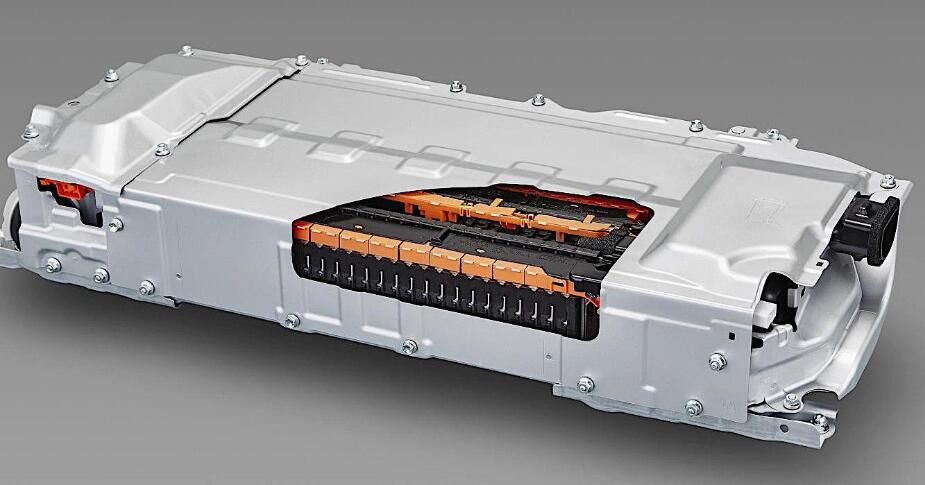
The Panasonic battery used by Tesla is a type of lithium-ion battery. A lithium ion battery is a secondary battery (rechargeable battery) that mainly relies on lithium ions moving between a positive electrode and a negative electrode to operate. During charge and discharge, Li+ is intercalated and deintercalated between the two electrodes: when charging, Li+ is deintercalated from the positive electrode, and the electrolyte is embedded in the negative electrode, and the negative electrode is in a lithium-rich state; The battery generally uses a material containing lithium as an electrode.
Its main advantages are high output voltage (3.6V), high energy density, small self-discharge, long cycle life, no memory effect, fast charge and discharge, and no toxic and harmful substances. The disadvantage is that temperature affects battery capacity and poor safety. At present, the main application areas are consumer electronics, electric vehicles, large power supplies, and secondary charging and energy storage.
Panasonic 18650 battery for Tesla ModelS18650 is the originator of lithium-ion battery--a standard lithium-ion battery model that Japan SONY Company set in order to save cost. Among them, 18 means diameter 18mm, 65 means length is 65mm, 0 means cylindrical battery.
The Model 18650 battery used by ModelS is a Panasonic ternary material battery of NCR18650B with a capacitance of approximately 3.3 mA, a voltage of 3.6 V, and an energy density of 243 Wh/kg.
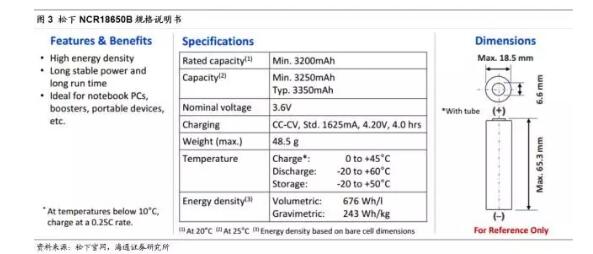
The NCR18650B used on Tesla's ModelS is 30% more energy than the lithium cobalt oxide battery used by the previous Roadster. The difference is due to the difference in structure. It uses nickel-cobalt-aluminum ternary material as the positive electrode material and graphite as the negative electrode material. Lithium hexafluorophosphate is used as an electrolyte. In the end, it achieves a greater than energy, stability and consistency. In addition, the single cell has a small size but high controllability, which can reduce the impact of a single battery failure, even if a unit of the battery pack fails, it will not affect the overall performance of the battery.
The structure of lithium batteries is various, and Panasonic ternary batteries are just one of them. Below we will mainly analyze lithium batteries in detail from the five core components of lithium batteries.
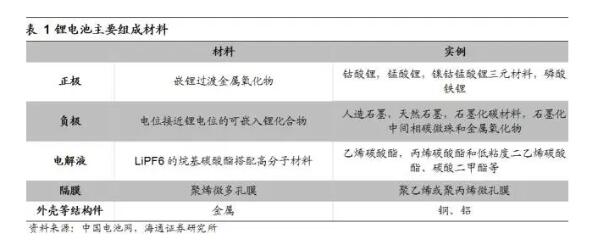
The positive electrode material determines the main properties of the lithium ion battery, such as energy density, cycle stability, safety, and the like. The cathode material currently mainly includes lithium cobaltate, lithium manganate, lithium iron phosphate and ternary materials. At present, the positive electrode of lithium battery follows the development trend from binary material to ternary material. The cathode material of Panasonic NRC18650B is nickel-cobalt-aluminum ternary material, commonly known as NCA.
By introducing the Ni content, the capacity of the material can be increased, and the Panasonic NRC18650B increases the Ni content (molar fraction of 80%), thereby increasing the battery from the original 2.9 Ah to about 3.3 Ah, and the energy density is greatly improved. At the same time benefiting from the ternary synergy effect, NCA cathode materials combine many advantages of LiNiO2 and LiCoO2, and the performance is superior to the use of a single material. Moreover, the material uses less cobalt and is less expensive.
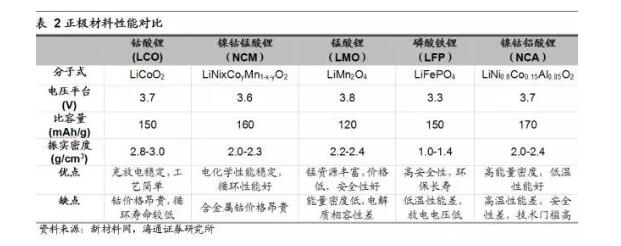
From the current market point of view, lithium iron phosphate and ternary materials are the two most mainstream cathode materials in China. Due to the large demand for lithium iron phosphate batteries in new energy buses, the market share of lithium iron phosphate is higher. However, the ternary materials have gradually developed with a relatively rapid momentum and become the future trend.
Whether it is lithium iron phosphate cathode material or ternary cathode material, lithium carbonate is inseparable. Take Tesla ModelS as an example to measure the lithium carbonate equivalent demand of a new energy vehicle: Panasonic NCR18650 battery cell weight 44g, Panasonic official website shows that the positive electrode material weight ratio of 18 to 35% in 18650 battery, assuming that its cathode material is 30% Left and right, the weight is about 15 grams. The NCA chemical formula Li(Ni0.8Co0.15Al0.05)xO2, after measuring x=0.845, has a molecular weight of 87.5; the lithium carbonate formula Li2CO3 has a molecular weight of 74. According to the lithium element one to one, the weight ratio of the two is 74: (87.5 & TImes; 2) = 0.423: 1.
It can be seen that 1 gram of lithium cobalt nickel aluminum ternary positive electrode material requires 0.423 g of lithium carbonate. The production of a 18650NCA ternary battery cathode material requires 15*0.423=6.345g lithium carbonate. A ModelS uses 7104 18650 batteries, equivalent to lithium carbonate equivalent = 7104 * 6.345g = 45.1kg, plus the electrolyte lithium hexafluorophosphate demand for lithium carbonate and industrial wear, it is estimated that a ModelS lithium carbonate equivalent demand is about 60kg The equivalent consumption is 0.73kg/kWh.
Calculated according to the same idea, we estimate that the nickel element consumption of the Panasonic ternary battery is about 0.53kg/kWh.
In addition, cobalt is also an indispensable upstream raw material for NCA and NCM ternary materials. As the substitution trend of ternary materials for lithium iron carbonate becomes more and more clear, the demand for cobalt also rises. The demand for cobalt in the NCA ternary material is about 0.14 kg/kWh.
Anode materialGraphite is still the first choice for anode materials
The negative electrode of the lithium ion battery is made by mixing a negative electrode active material carbon material or a non-carbon material, a binder and an additive to form a paste adhesive, which is evenly coated on both sides of the copper foil, and dried and rolled. The negative electrode material is a main body for storing lithium in a lithium ion battery, so that lithium ions are inserted and removed during charging and discharging.
The negative electrode materials are mainly classified into the following three types: carbon materials (graphites), metal oxide materials, and alloy materials. The anode material of the Panasonic NCR18650B battery is made of graphite.
Since the outbreak of the power battery market, the price of the anode material is relatively stable compared to other materials, and the technical route is mainly graphite, and there is no big controversy. According to China Battery Network data, taking a power lithium battery as an example, a new energy vehicle needs about 40 kilograms of anode material, and the graphite consumption is about 0.9kg/kWh. At present, the negative electrode materials are mainly composed of natural graphite and artificial graphite, and their performances have their own advantages and disadvantages, and the application fields are also different.

The most advanced product in the development of carbon materials is graphene, which is the thinnest layered material discovered so far, and the capacity of the battery can be increased by using graphene as a negative electrode material. The upper limit of energy density (graphene) of conventional graphite materials is 372 mAh/g, which is quite marginal than the energy density of current cathode materials. In the future, improving the energy density of power batteries is still the key to the power of new energy vehicles. Although expensive or technically immature, high-end anode materials such as lithium titanate and silicon-based composite materials are gradually entering the application field of anode materials.
ElectrolyteThe electrolyte is a carrier for driving lithium ions in a lithium ion battery, and plays an important role in the operation and safety of the lithium battery. The working principle of lithium-ion battery is also the process of charging and discharging, which is characterized by the lithium ion passing between the positive and negative electrodes, and the electrolyte is the medium for lithium ion flow.
According to the calculation of China's battery network, in the cost structure of the electrolyte, the solvent accounts for about 30%, the additive accounts for about 10%, and the most important component solute accounts for about 60%. The solute on the market is mainly lithium hexafluorophosphate (LiPF6), and the Panasonic NCR18650 battery also uses lithium hexafluorophosphate as the solute. It requires 0.15 kg of lithium hexafluorophosphate per kWh of lithium battery. Lithium hexafluorophosphate can also be prepared by lithium carbonate.
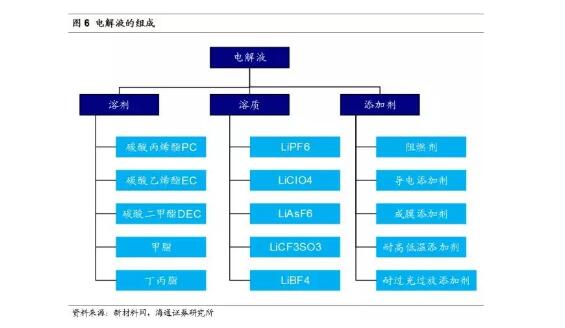
The main function of the diaphragm is to ensure the free flow of lithium ions in the case of separation of the positive and negative electrodes, which is one of the most important parts to ensure battery safety. The membrane can be immersed in the electrolyte and has a large number of micropores on the surface that allow lithium ions to pass through. Micropore density, as well as material selection, thickness, etc., affect the rate at which lithium ions pass through the separator and affect battery performance. China Industrial Information Network estimates that the consumption of diaphragms in lithium batteries is roughly 20m2/kWh.
The diaphragm used by Panasonic to supply Tesla's batteries is supplied by Sumitomo Chemical. Sumitomo Chemical Separator uses a single layer of PE as the base material and is processed by a wet process. Compared with the dry process, the investment cost of the wet process is higher, but the number of micropores on the surface of the film can be increased, and the produced separator is thinner. This is also the biggest advantage of the wet process, the film thickness can be as low as 9μm, and the thickness of the separator produced by the dry process is usually 20-40μm.
Lithium battery structureAs an important part of lithium battery and battery module, precision structural parts mainly include aluminum/steel shell, cover plate and connecting piece, which have direct influence on the safety, airtightness and energy efficiency of lithium battery. Since new energy vehicles require a large number of battery strings and are connected in parallel to ensure energy supply during use, a large number of structural components are required to ensure the safety of the power battery.
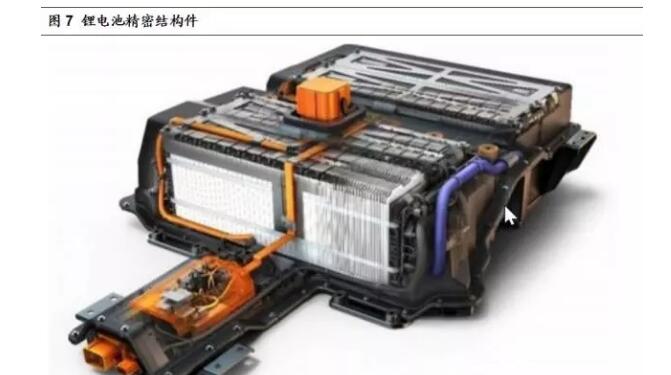
The lithium battery case protects the battery from external damage during storage and use and maintains the internal stability of the battery. It has a direct impact on the safety, sealing and consistency of the battery. It is one of the important components of the lithium battery. Depending on the shape of the lithium battery, the housing materials used are different: the cylindrical battery case is mainly made of steel. The square battery case is mostly made of aluminum shell, and the soft pack battery is mainly packaged with aluminum plastic film and tabs.
The battery contact piece is an important part of the battery and is made of copper, iron, stainless steel and the like. Electroplated gold, silver, nickel, tin. When the battery contact piece mounted on the conductive film is pressed, the center point of the contact piece contacts the battery to form a loop, and current flows. It has the characteristics of strong conductivity and good hand feeling.
Description
✿Service Life
Mechanical ≥ 1000000cycles
Electrical ≥ 50000cycles(Degree of protection againstDepend on model No.
✿Approvals
UL CUL VDE TUV CE DEMKO CQC
✿ Material
Made of high quality plastic and metal, rust resistance and corrosion resistance, durable enough for you to hanging items, So the product appearance is exquisite, perfect workmanship.
✿ Rating
You can meet the different RATING daily needs. Please pay attention to the model of the switch before purchase, to ensure that you purchase the same as you need.
✿ Vairous Sizes
Actuator Action is momentary and Actuator Type is long straight hinge lever. Switch Body Size as shown in the picture.So different sizes can meet all your daily different needs.
✿ Wide Application
Home appliance: micro oven, electric cooker, washing machine, electric heater, warmer, water fountain and so on.
Commercial appliance: Vending machine, electric toy, electric tools, duplicating machine and so on.
Machinery: Transport machinery, printing machinery, textile machinery and so on.
Basic Micro Switch,Micro Power Switch,Waterproof Micro Switch,Micro Switch Limit Switch
Ningbo Jialin Electronics Co.,Ltd , https://www.donghai-switch.com
